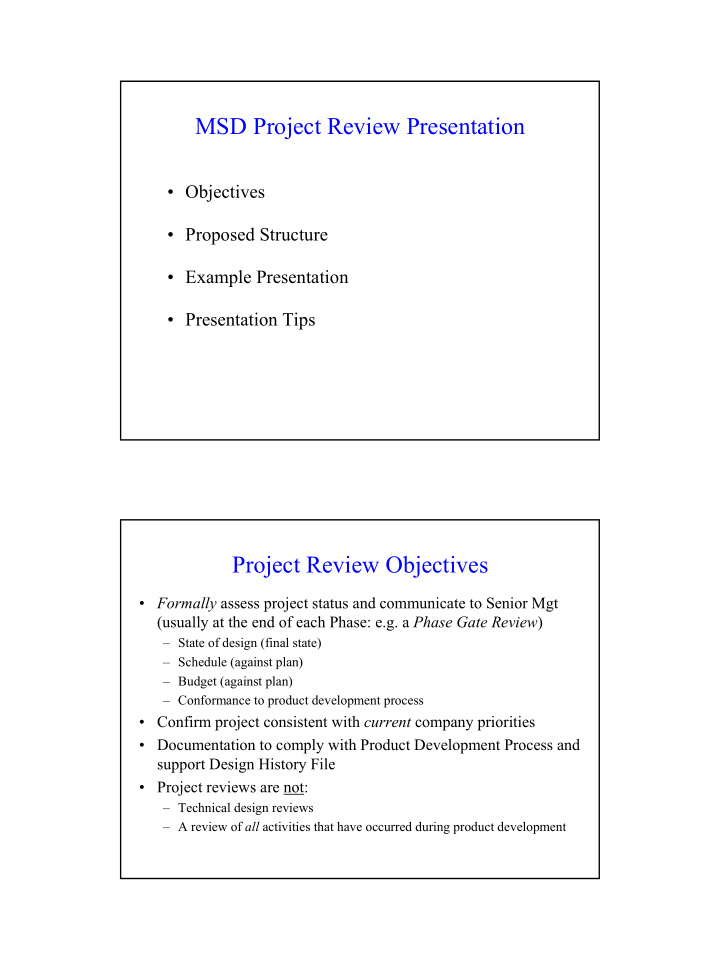



MSD Project Review Presentation • Objectives • Proposed Structure • Example Presentation • Presentation Tips Project Review Objectives • Formally assess project status and communicate to Senior Mgt (usually at the end of each Phase: e.g. a Phase Gate Review ) – State of design (final state) – Schedule (against plan) – Budget (against plan) – Conformance to product development process • Confirm project consistent with current company priorities • Documentation to comply with Product Development Process and support Design History File • Project reviews are not: – Technical design reviews – A review of all activities that have occurred during product development
Proposed Project Review Structure • Title Slide: Project title, Team members / roles, Sponsor • Project Description / High Level Customer Needs / Eng Specs • Concept Description and Rationale (MSD I) Concept Summary (MSD II) • System Architecture • High Risk Assessment (MSD I) Design Summary (MSD II) • Current State of Design: performance/budget/schedule (MSD I) System Testing Results (MSD II) • Milestone Schedule for next quarter (MSD I) Objective Project Evaluation: Success and Failure (MSD II) • Opportunities/Suggestions for Future Work (MSD II) P08907: Portable Beverage Opening Device with Integrated BAC Monitoring Dr. B.R. Bellie Project Manager B.D. Weiser Marketing H.N. Kinn Test Engineer M.K. Lobe Mechanical Engineer S. Adams Electrical Engineer Note: This is a hypothetical Sponsor: Anheuser-Busch project and is not sponsored nor endorsed by Anheuser-Busch KGCOE Multidisciplinary Sr. Design Borkholder 2007
Project Description • Device to open bottle beverage containers • Market: Males age 21-32 • Key high level customer needs / engineering specs: – Portable (carry in pocket) Size < 8cm x 3cm x 1cm Weight < 3 oz Batteries for 100 tests Drop of at least 2 meters – Universal (beer or EANABs) Caps from 2.5-3cm O.D. Soda can tab lifter – Built in breathalyzer Range: 0.500 % BAC Resolution: ± 0.01 % BAC – No training required Digital display KGCOE Multidisciplinary Sr. Design Borkholder 2007 Design Concept Mouthpiece for Breathalyzer BAC display Convenience Key Ring Titanium Case Bottle Opener Soda Can Tab Opener KGCOE Multidisciplinary Sr. Design Borkholder 2007
System Architecture Alcohol Flow Air Mouthpiece Air Air Air Exhaust Port Air Sensor Sensor Amplification / ADC filtering Power System Test on Switch Startup Power System LCD Driver Microcontroller Batteries 2 AAA Digital Display KGCOE Multidisciplinary Sr. Design Borkholder 2007 Technical Risk Assessment • Risk: Breathalyzer accuracy with variable “blow” rates – Breadboard alcohol sensor and test with air saturated with fixed % alcohol at flow rates from 0.1 to 5 liters/min – Accuracy of 0.01% requires flow rate in excess of 2 liters/min – Sensing technology acceptable at all required environmental conditions and BAC levels • Reviewed results with project team and customer • Mitigations: – Flow sensor to measure flow rate of air – Test results invalidated for flow rates below 2 liters/min – Display will flash for user feedback (links to “no training required” customer need) KGCOE Multidisciplinary Sr. Design Borkholder 2007
Current State of Design • Design meets all customer needs • Design meets engineering specifications for full system and subsystems except: – Battery life ~ 80 tests – Weight 3.5 oz • On target to meet project budget of $1200 except for overrun on cost of goods – Budget COG (ea) = $120 – Actual COG (ea) = $200 • Schedule: three weeks behind schedule on power system design • Moderate confidence in drop specification • Mitigations: – Battery life and weight minimal impact to business case � accepted – COG changes marketing plan: Need approval or reduction in features – Finalize design over Fall/Winter break to regain schedule slip KGCOE Multidisciplinary Sr. Design Borkholder 2007 Product Development Process Phase Phase 0: Planning Phase 1: Concept Development Phase 2: System Level Design Phase 3: Detailed Design Phase 4: Testing and Refinement MSD I MSD II Alpha Prototype 0 1 2 3 4 Current Phase of Development KGCOE Multidisciplinary Sr. Design Borkholder 2007
MSD II Project Schedule Milestones • Dec 3: Design finalized and all parts on order (MSD I milestone) • Jan 14: Functional alpha prototype (full featured) • Jan 28: Design verification testing complete, initiate design revisions • Feb 11: Design Verification Testing Results Complete • Feb 15: Documentation Finalized: DHF, Formal Paper, Poster • Feb 20: Project Review - Phase 4 Completion KGCOE Multidisciplinary Sr. Design Borkholder 2007 Presentation Tips • Formal PowerPoint presentation • Keep background simple � audience focus on content • Avoid animations unless functional • Use colors that show up well (e.g. avoid yellow on white) • Make text large (never < 18 point ) including figures! • Bring hardcopy handouts for audience (5 copies) • Limit number of speakers – All team members should speak � break at logical locations – Avoid “round robin” organization (i.e. speak only once) • Dress professionally • Practice in front of other teams – Time < 20 minutes + 5 minutes questions KGCOE Multidisciplinary Sr. Design R • I • T Borkholder 2007
Recommend
More recommend